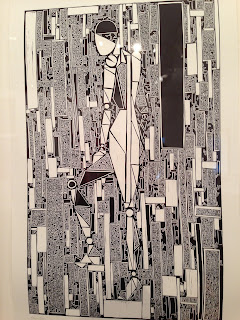When I first started using Facebook, it was because one of my ex- students asked me to keep in touch that way. As both she and I had continually changing work positions and/or addresses, it was the easiest way to keep in touch. Then, when I visited Spain, I used it as a method of writing to friends and family about our travels and experiences. I expanded to having a " professional" Facebook site, Patapan Art, and having blogs, Patapan Art and Patapan Food, because I felt isolated, living here in Brisbane, from a lot of my friends and family in Victoria, 1686 kilometres away, and overseas, and felt that this would be the easiest way of keeping them up-to-date with what I was doing as an artist and a cook, since they were always asking.
It has been a surprise, therefore to learn that it is not my friends and family that are my main readers. In fact, I suspect that very few people I know regularly follow my blogs because they have very full lives and are busy. In fact, my biggest readers are people I don't know in Alaska, Germany, Russia, South Korea, Japan, China, Romania, Poland , as well as the expected UK, USA and Australia. So here's to you, unknown readers, in countries I hope to visit in the future. This blog is dedicated to those of you who know little about Australia.
Australia has a lot of very good artists in a range of media, and we have a number of very good galleries in both urban and rural locations. Emigrants who live here may miss the sense of history found in, for instance, European art galleries and museums :
(tapestry from the museum in Sevilla)
( Roman mosaic floor in museum , Merida, Spain)
(statuettes in Museum, Copenhagen, Denmark).
and Asian galleries and museums
(Stone carving from the Museum of Champa, Danang, Vietnam).
(Fabric in museum, Takayama, Japan)
We have only a few representatives of, for instance, European medieval art or Chinese porcelain painting, but we do frequently get excellent travelling shows of artists like Monet here. And we frequently have excellent representatives from Asia showing here, as can be seen by these examples from GOMA's Asia Pacific exhibition in 2009
(Zhu Weibing and Ji Wenyu "People holding flowers")
(Subodh Gupta "Line of Control").
In addition, a lot of foreign artists visit our shores to run workshops.
Moreover, I think people forget that aborigines have been making art here for centuries. Furthermore, I believe we make up any gaps in "European or Asian style tradions" with interest. The art galleries and museums here are an excellent way of getting an understanding of Australian history and changing culture. Plus, not being restrained by tradition, and coming from an evolving culture, I think Australian art is very exciting and different.
(Portrait by Ah Xian)
Brisbane is quite a centre for artists and it is easy to find a variety of arts and crafts at varying prices. I think this has a lot to do with the relatively good weather since a lot of emerging artists use the large number of markets to reach prospective customers. But, there are quite a few galleries too, an innovative museum, and a very good art centre. So, this is a very encouraging place for someone to start an art career, as I have found.
So, dear readers, keep an eye out for Australian artists on lime, and visit us if you can. I am sure you won't be disappointed
I have continued working on my canvases this week. They are both very experimental, teaching me how the same basic materials can be used in different ways, and I am having enormous fun. In the little one I showed you last week, I coloured some modelling putty with ink, and used the new fish stencil I cut out, to create a raised area of fish scales and tails, etc. After it had dried, I added more, darker ink and created the body of the fish. Add the eyes, and hey presto! More koi!
On the larger canvas, I used the same stencils I had used for fabric work and for the small canvas, plus modelling putty, to create raised patterns of Japanese style plants and insects on the gessoed background. Once dry, I washed the canvas with a pale blue ink. The next step was to use darker blue hues to create contrasts, textures and depth. Japanese paper added further interest and texture and help unite the design. Finally, more layers of white and blues were added. An ink patchwork on canvas, finished.
I am continuing to knit at night to try and finish off the doll's jacket, but it is rather slow going as I keep getting distracted. Never mind, there is no time-line.
And I have started on another quilt using my hand dyed fabrics. Just cutting the fabric now, then I'll consider whether to layer printing, photos or embroidery - or all - on top!





























































